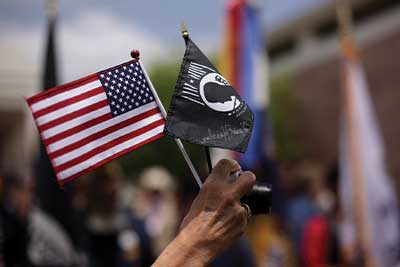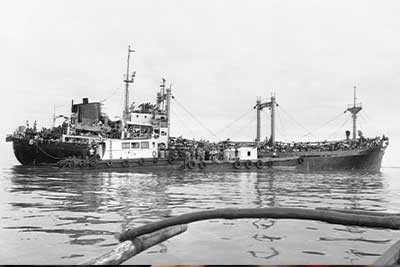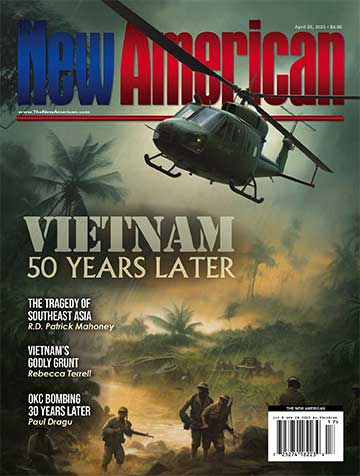Americans Are Still Paying for the Vietnam War
The fall of Saigon 50 years ago on April 30 occasioned more than the haunting, humiliating scene of U.S. Army Huey helicopters lifting in defeat off the roof of the American embassy in Saigon, now Ho Chi Minh City — that name change being, perhaps, the final, emphatic statement that a Third World nation had beaten the world’s greatest superpower.
By the time American involvement in Vietnam ended, taxpayers had funneled some $140 billion into the war, although “no figures are available on the exact amount of economic and military assistance channeled to Vietnam since 1950, when the United States agreed to give arms aid to the French-sponsored states of Indochina,” CQ Almanac reported in 1975. That $140 billion a half-century ago would be $1 trillion today.
And that cost, the almanac continued, did not count veterans benefits of some $33 billion or, most importantly, the deaths of 58,281 Americans whose names appear on the once-controversial memorial wall in Washington, D.C. Nor does it count the millions of Vietnamese who died during the war.
Any American about 60 years old or older will remember a brutal and seemingly endless struggle. But most don’t know that the costs of the war continued long after the United States pulled out in 1973.
The loss of South Vietnam to Hanoi’s brutal communists led to other sequelae: Prisoners of war left behind to die at the hands of their captors, the murder of millions of Vietnamese, the wave of “boat people” who fled the communist regime for the United States and other countries, and the resumption of foreign aid in 1991 that was a mind-blowing $270 million in fiscal 2024 alone. And now the United States is exporting military aid to Vietnam.
All that brings to mind the late conservative columnist Holmes Alexander’s admonition in the title of his last book: Never Lose a War.
The POWs
As the late Vietnam war hero Patrick Mahoney reminds readers in a piece republished in this issue (see page 13), U.S. Marine Corps General Raymond Davis, a Medal of Honor recipient during the Korean War and commander of the 3rd Marine Division in Vietnam, called the U.S. war policy that led to defeat a “total disaster.”
Part of that disaster was the abandonment of “probably hundreds” of American POWs in Vietnam and Laos, as Pulitzer Prize-winning writer Sydney Schanberg, who died in 2016, wrote in his famous account of the POW coverup for The Nation in 2008.
Schanberg’s “McCain and the POW Cover-up” proved beyond doubt that President Richard Nixon lied when he announced that Vietnam had returned all American POWs after the United States signed the Paris Peace Accords in 1973. He also detailed the role that now-deceased U.S. Senator John McCain (R-Ariz.) played in perpetuating that lie, likely because of questions about his behavior while he was a prisoner.
Government failure: Two Vietnam-era defense secretaries told a U.S. Senate select committee that they believed POWs were left behind in Vietnam. Two Delta Force missions to rescue the men during the Reagan administration were scrapped. (AP Images)

Schanberg’s evidence that the Nixon administration left American fighting men behind, and that other administrations refused to get them back, was shocking. Schanberg didn’t just prove that POWs were alive years after the war. He also showed that presidents from Nixon through Ronald Reagan did nothing to secure their release, despite the Vietnamese communist regime’s apparent willingness to trade POWs for money.
Examples of the evidence that POWs were still alive include:
• The Defense Intelligence Agency (DIA) collected 1,600 first-hand and 14,000 second-hand reports about live Americans. “Some of the witnesses were given lie-detector tests and passed,” Schanberg wrote. “Sources provided me with copies of these witness reports, which are impressive in their detail.… Yet the DIA, after reviewing all these reports, concluded that they ‘do not constitute evidence’ that men were alive.”
• Thai communications officers reported that American POWs were moved among camps, Schanberg wrote:
On December 27, 1980, a Thai military signal team picked up a message saying that prisoners were being moved out of Attopeu (in southern Laos) by aircraft “at 1230 hours.” Three days later a message was sent from the CIA station in Bangkok to the CIA director’s office in Langley. It read, in part: “The prisoners … are now in the valley in permanent location (a prison camp at Nhommarath in Central Laos). They were transferred from Attopeu to work in various places … POWs were formerly kept in caves and are very thin, dark and starving.” Apparently the prisoners were real. But the transmission was declared “invalid” by Washington because the information came from a “third party” and thus could not be deemed credible.
• Government satellite photos show U.S. military distress signals on the ground even in the late 1980s and early 1990s. The “markings on the ground [were] identical to the signals that American pilots had been specifically trained to use in their survival courses — such as certain letters, like X or K, drawn in a special way.” As well, “other markings were the secret four-digit authenticator numbers given to individual pilots,” Schanberg explained. The Pentagon dismissed the images as “shadows and vegetation.” One photo showed a missing American’s name “gouged into a field.” Pentagon verdict: Nothing to see here. Go back to your homes. NOTHING TO SEE HERE.
• Some of the most compelling information came from something called PAVE SPIKE, a classified program that used “motion sensors, dropped by air, designed to pick up enemy troop movements. Shaped on one end like a spike with an electronic pod and antenna on top, they were designed to stick in the ground as they fell,” Schanberg wrote.
But the spikes buried in the ground didn’t just collect intelligence about enemy movements. “Someone on the ground — a downed airman or a prisoner on a labor gang — could manually enter data into the sensor. All data were regularly collected electronically by US planes flying overhead.”
Schanberg noted that, according to Dolores Alfond, sister of a missing airman and chair of a group of POW relatives:
In 1974, a year after the supposedly complete return of prisoners, the gathered data showed that a person or people had manually entered into the sensors — as US pilots had been trained to do — “no less than 20 authenticator numbers that corresponded exactly to the classified authenticator numbers of 20 US POWs who were lost in Laos.”
For anyone who mightn’t believe that evidence, Schanberg reported on the work of Harvard researcher Stephen Morris, who found and published the transcript of General Tran Van Quang’s briefing to North Vietnam’s politburo in 1973, four months before Secretary of State Henry Kissinger inked the Paris peace pact.
“Quang told the Hanoi politburo that 1,205 US prisoners were being held,” Schanberg wrote of the transcript:
Quang said that many of the prisoners would be held back from Washington after the accords as bargaining chips for war reparations. General Quang’s report added: “This is a big number. Officially, until now, we published a list of only 368 prisoners of war. The rest we have not revealed. The government of the USA knows this well, but it does not know the exact number … and can only make guesses based on its losses. That is why we are keeping the number of prisoners of war secret, in accordance with the politburo’s instructions.” The report then went on to explain in clear and specific language that a large number would be kept back to ensure reparations.
The reparations figure was $3.25 billion, which Congress refused to approve. After the French paid reparations when they withdrew from their war, Vietnam released French POWs.

Boat people: As many as two million people fled Vietnam on boats. Anywhere from 200,000 to 400,000 died. (AP Images)
Kissinger revealed to GOP Senator Bob Smith of New Hampshire, vice chairman of the select committee that probed the POW issue from 1989 to 1993, that Nixon had threatened to bomb North Vietnam unless it released all the POWs. Nixon did not follow through. The former secretary of state revealed in his memoirs that “we knew of at least 80 instances in which an American serviceman had been captured alive and subsequently disappeared.… Yet none of these men was on the list of POWs handed over after the Agreement.”
But Kissinger isn’t the only top Nixon official to come clean. Vietnam War defense secretaries Melvin Laird and James Schlesinger also testified to the committee that POWs were abandoned.
Fast forward to the Reagan administration and Command Sergeant Major Eric Haney, a Delta Force operator. Haney revealed that Delta trained for a POW rescue mission in 1981 that was aborted. Likewise, another such mission was “abruptly aborted” the following year. “Years later, I spoke at length with a former highly placed member of the North Vietnamese diplomatic corps,” an upset Haney wrote, “and this person asked me point-blank: ‘Why did the Americans never attempt to recover their remaining POWs after the conclusion of the war?’”
Haney wasn’t the only Reagan-era witness to the men left behind. Also in 1981, through an intermediary nation, Vietnam offered to ransom POWs, an offer top officials discussed in the Roosevelt Room of the White House, Schanberg wrote. President Ronald Reagan was there, as were Vice President George H.W. Bush, a former CIA chief; CIA Director William Casey; and National Security Advisor Richard Allen.
Allen confirmed the offer in sworn testimony to the Senate POW committee on June 23, 1992, Schanberg wrote:
Allen was allowed to testify behind closed doors and no information was released. But a San Diego Union-Tribune reporter, Robert Caldwell, obtained the portion relating to the ransom offer and reported on it. The ransom request was for $4 billion, Allen testified. He said he told Reagan that “it would be worth the president’s going along and let’s have the negotiation.” When his testimony appeared in the Union-Tribune, Allen quickly wrote a letter to the panel, this time not under oath, recanting the ransom story and claiming his memory had played tricks on him. His new version was that some POW activists had asked him about such an offer in a meeting that took place in 1986, when he was no longer in government. “It appears,” he said in the letter, “that there never was a 1981 meeting about the return of POW/MIAs for $4 billion.”
A witness who recants sworn testimony, particularly in this case, is legally problematic. And obviously, those men did meet in the Roosevelt Room to discuss the ransom. Just as obviously, they decided against it, possibly because it might encourage such demands from terrorists. Whatever the reason they abandoned the POWs, someone obviously strong-armed Allen into reversing himself, despite testimony given under oath. Allen, the last surviving witness to the meeting, took the truth to his grave in November last year.
The one man who did the most to cover up the scandal, Schanberg wrote during McCain’s failed GOP presidential candidacy, was McCain himself. Scion of a prominent Navy family — McCain’s father was commander in chief of the Pacific during the Vietnam War — McCain was “the war hero who people would logically imagine as a determined crusader for the interests of POWs and their families [who] became instead the strange champion of hiding the evidence and closing the books.”
Indeed, despite the mountain of evidence that American POWs were abandoned, McCain wrecked two pieces of legislation that would have required government transparency about the matter. Through the years, “McCain has insisted again and again that all the evidence — documents, witnesses, satellite photos, two Pentagon chiefs’ sworn testimony, aborted rescue missions, ransom offers apparently scorned — has been woven together by unscrupulous deceivers to create an insidious and unpatriotic myth,” Schanberg wrote:
He calls it the “bizarre rantings of the MIA hobbyists.” He has regularly vilified those who keep trying to pry out classified documents as “hoaxers,” “charlatans,” “conspiracy theorists,” and “dime-store Rambos.”
But we now know the truth, from the words of U.S. and communist North Vietnamese officials and one would-be rescuer who was slated for a mission to bring the men home.
Sylvester Stallone’s Rambo was right. Gene Hackman’s Colonel Cal Rhodes in Uncommon Valor was right. Chuck Norris’ Colonel James Braddock in Missing in Action was right. The U.S. government abandoned its POWs in Southeast Asia. And all of them almost certainly died there.
The decades of pain and suffering among the families of POWs who were known to have been taken prisoner and never returned is just one of the baleful effects of permitting North Vietnam to seize the whole country in 1975.
Refugees, Democide, and Free Money for the Communists
The North Vietnamese Reds had barely raised their flag over South Vietnam when South Vietnamese civilians and former soldiers began a mass exodus, boarding small, sometimes barely seaworthy, boats to escape communist tyranny.
The refugees who fled would have faced “forced relocation, being held as political prisoners, and even death” in the newly united Socialist Republic of Vietnam, National Geographic explained. An estimated 200,000 to 300,000 former soldiers, government officials, and supporters of the government of South Vietnam landed in “re-education camps” for brainwashing.
Thus were 120,000 Vietnamese dropped into the United States, where President Ford asked “a coalition of church groups, southern Democratic governors, labor leaders, and the American Jewish Congress to secure housing and jobs.”
Others weren’t so lucky, and became the “boat people.” Estimates of those who boarded boats to flee in the South China Sea range as high as two million, and somewhere between 200,000 and 400,000 died at sea. Their destinations included countries across Asia, including Singapore, Indonesia, Malaysia, and the Philippines. Many continued to the First World, notably, again, the United States.
“As the humanitarian crisis and displacement of people in the Indochina region (Vietnam, Cambodia, and Laos) intensified, more refugees and their families were admitted to the United States,” the Migration Policy Institute reported in 2018:
The Vietnamese immigrant population has grown significantly since then, roughly doubling every decade between 1980 and 2000, and then increasing 26 percent in the 2000s. In 2017, more than 1.3 million Vietnamese resided in the United States, accounting for 3 percent of the nation’s 44.5 million immigrants and representing the sixth-largest foreign-born group in the country.
In 1980, just 231,000 Vietnamese were in the United States. By 1990, the figure was 543,000, and 10 years later, 988,000. The figure hit 1.241 million in 2010, and by 2017 was 1.343 million.
They were lucky. Aside from attempting to brainwash their former enemies, the communist “liberators” of South Vietnam murdered millions who didn’t flee after the war. R.J. Rummel, author of Death by Government, estimates that communist governments in Southeast Asia murdered 3.5 million people between 1975 and 1995: 528,000 in Vietnam, 130,000 in Laos, and 2.85 million in Cambodia. Rummel estimated that 250,000 boat people died.
After the three countries held POWs for reparations and ransom, then drove millions of Vietnamese into the sea and murdered millions more, one might imagine that the United States would see to it that not a single penny of taxpayer-subsidized foreign aid went to Vietnam, Laos, or Cambodia. Alas and alack, former POWs and other Vietnam veterans, along with the families of missing men and those who died there, can take comfort in knowing the U.S. government has lavished billions of dollars in “foreign aid” on those nations.
Fate unknown: 58,281 Americans died during the Vietnam War. But at least the families of those men knew what happened to them. The families of hundreds of POWs whom Vietnam refused to return still don’t know their fate. (AP Images)

Disbursed foreign aid to Vietnam in 2024 alone was about $270 million; most of it, of course, from the U.S. Agency for International Development. But from 2001 through part of fiscal 2025, the figure is a mind-boggling $2.73 billion. Laos and Cambodia have cashed in on taxpayers as well, ForeignAssistance.gov shows.
Yet Vietnam isn’t just receiving taxpayer money. The United States also sells military supplies and weapons to its former enemy, presumably as a hedge against China. On Day 1 of the new Trump administration, the State Department announced that the United States is growing ever closer to its erstwhile communist enemy.
“The U.S. security relationship with Vietnam continues to expand and the two countries share a common vision for the future of a free and open Indo-Pacific region,” the department announced. The two nations “have held 12 Political, Security, and Defense Dialogues to discuss bilateral security cooperation.” Those included such topics as “legacy of war issues, security cooperation (regional issues, maritime security, humanitarian assistance), peacekeeping operations, and other security initiatives.”
In March 2018, during the first Trump administration, the USS Carl Vinson, a Nimitz-class supercarrier, visited the nation, the first such event in nearly half a century. The USS Theodore Roosevelt sailed into port two years later for five days, the department continued:
Sailors participated in cultural exchanges and community service projects including making crafts, playing sports, a language exchange, gardening, and painting, demonstrating the importance of people-to-people ties between the United States and Vietnam. A professional exchange also took place during the visit focused on cooperating on infectious disease prevention.
From 2016 through 2021, the United States exported almost $30 million of “defense articles” to Vietnam, including “Fire Control / Night Vision ($25.5 million), ... Electronics ($1.8 million), and ... Firearms and related articles ($777,592),” while the United States “has over $118 million in active Foreign Military Sales with Vietnam.” And from fiscal 2017 through 2023, Vietnam collected $104 million from the U.S. State Department in security assistance, plus a separate $81.5 million for Indo-Pacific Strategy in 2018.
Since 1993, the United States has also provided Vietnam $230 million to find unexploded ordnance (UXO) from the war. That money is for “locating and destroying UXO, information management, risk education, survivors’ assistance, and capacity building for the Vietnam National Mine Action Center.”
The department’s release does not mention the American prisoners of war that Vietnam never returned, or what Vietnam has done for the families of those men. “Survivors’ assistance” for them, apparently, isn’t part of the new bargain.
The United States lost the war, and Americans still pay for it.


